20+ Jungle Animals: List of Animals that Live in the Jungle: Welcome to the hidden magical world of the jungle. The jungle is filled with life from the smallest animal to the largest animal. The animals that live in the jungle are some of the most fascinating and impressive creatures you will ever encounter.
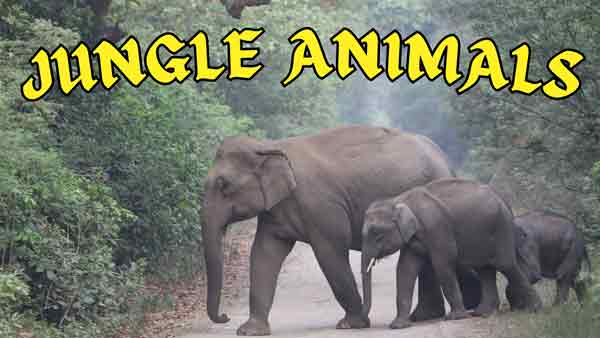
Do you know all about animals living in the jungle? Think again! A jungle is a place where animals like the elusive jaguar and the playful monkeys are waiting to be discovered. So, put on your safari hat, grab your binoculars, and prepare to begin on a journey as we explore the delightful world of cute jungle animals. But don’t worry; I promise we will be safe. Or at least for a short time.
Here in this post, we will learn about 18 amazing animals living in the forest. You’ll learn about the unique adaptations and behaviors of these amazing animals and gain a new understanding of the magic of the jungle ecosystem.
Let’s have a look at the list of jungle animals.
Jungle Animals: List of Animals that Life in the Jungle
Awe-Inspiring Beasts of the Jungle: 5 Large Mammals You Need to See
If small mammals are the cute and cuddly animals of the jungle, then large mammals are their awe-inspiring counterparts. These beasts command respect with their size and power, and seeing them in their natural habitat is a once-in-a-lifetime experience. In this section, we’ll introduce you to 8 of the most impressive large mammals that call the jungle their home.
1. Black Bear
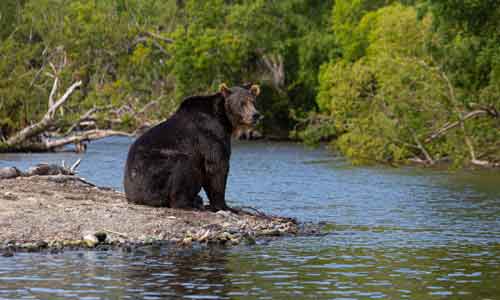
| Scientific Name: Ursus americanus |
| Type of Animal: Mammal |
| Family: Ursidae |
| Conservation Status: Least Concern |
The black bear is also called the American black bear. The black bear is a large mammal found in the forests of North America, from Alaska and Canada to Mexico.
The black bear is one of the most iconic jungle animals and for a good reason. These majestic animals can weigh up to 600 pounds and stand over six feet tall on their hind legs. They have a keen sense of smell and are known for their curious and intelligent behavior.
Black bears are omnivorous and consume a wide variety of foods including fruits, berries, insects, sedges, fish, honeycomb, and small mammals. Black bears are not usually aggressive towards humans, they can be dangerous if they feel threatened.
2. Tiger

| Scientific Name: Panthera tigris |
| Type of Animal: Mammal |
| Family: Felidae |
| Conservation Status: Endangered |
Tiger is one of the most iconic animals in the jungle. They are apex predators and have no natural predators.
Tigers are mainly found in the jungles of Asia. They can live in a variety of habitats such as tropical jungles, grasslands, and wetlands, where they prey on deer, wild boar, tapirs, wild bears, and other small animals. The tiger population has declined significantly due to habitat loss and hunting.
Tiger is one of the most recognizable animals in the world for their distinctive orange coat fur and black stripes. Humans are one of the major threats to the dwindling population of tigers in the wild. Many efforts are being made to protect them and their habitats.
3. Tapir
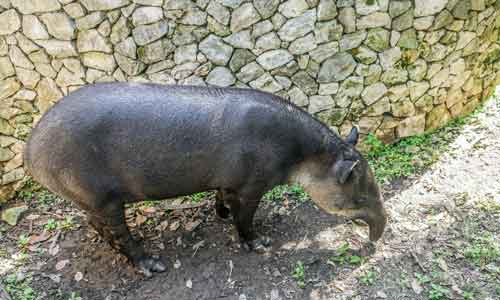
| Scientific Name: Tapirus spp. (various species) |
| Type of Animal: Mammal |
| Family: Tapiridae |
| Conservation Status: Endangered |
Tapir is a group of large herbivorous mammals that belong to the Tapiridae family. They are mainly found in tropical and subtropical regions of Central and South America, as well as some parts of Southeast Asia.
There are four widely recognized species of tapir in the world: the South American tapir, the mountain tapir, the Malayan tapir, and the Central American tapir. All four tapir species are currently classified as either vulnerable or endangered by the International Union for Conservation of Nature (IUCN).
Tapirs are predominantly active at night, spending most of their day resting in the shade to avoid the heat of the sun. They are really good swimmers and are able to submerge themselves in water to escape from predators or to find food.
4. Leopard

| Scientific Name: Panthera pardus |
| Type of Animal: Mammal |
| Family: Canidae |
| Conservation Status: Vulnerable |
Leopard is a slender and muscular animal. They are known for their beautiful spotted coats, ringed tails, and powerful bodies.
The leopard is found in a wide range of habitats in sub-Saharan Africa, some parts of western and central Asia, and Southeast Asia. Like many other jungle animals, deforestation is a major reason for the decline in the leopard population.
Leopards are comfortable living and resting in trees. They are powerful hunters capable of hunting from perch in trees. When they hunt, they take their prey to trees to protect them from lions or hyenas.
5. Moose

| Scientific Name: Alces alces |
| Type of Animal: Mammal |
| Family: Cervidae |
| Conservation Status: Least Concern |
The moose is the largest and heaviest species of the deer family and one of the iconic animals of the Northern Hemisphere. They are found in the northern part of North America, throughout Canada, Alaska, the northeastern United States, and right down into the Rocky Mountains in Colorado.
The moose is the most prominent deer family member and a true jungle giant. These magnificent creatures can weigh up to 1,500 pounds and stand over seven feet tall at the shoulder. Despite their size, they are surprisingly agile and can run up to 35 miles per hour.
Moose are herbivores and they consume many types of plants and fruits. Their diet includes twigs, leaves, grasses, aquatic plants, woody plants, shrubs, and bark.
6. Bobcat

| Scientific Name: Lynx rufus |
| Type of Animal: Mammal |
| Family: Sciuridae |
| Conservation Status: Least Concern |
Bobcat is also called a red lynx. The bobcat is a medium-sized predator in North America’s forested areas. Bobcats are highly adaptable species that can be found in a variety of habitats across North America, including forests, grasslands, deserts, swamps, farmland, mountains, and even suburban areas.
These elusive creatures are skilled hunters with sharp claws and excellent night vision. While they are usually solitary, they are known for their distinctive yowl, which you hear echoing through the jungle at night.
Bobcats are carnivorous predators and their diet includes small rodents, such as rabbits, muskrats, squirrels, moles, and mice. They are also known to prey on birds, fish, reptiles, and small deer.
7. White-Tailed Deer
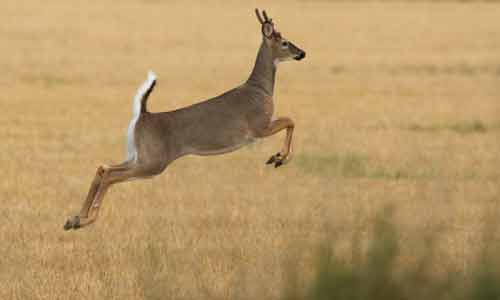
| Scientific Name: Odocoileus virginianus |
| Type of Animal: Mammal |
| Family: Cervidae |
| Conservation Status: Least Concern |
The white-tailed deer is a medium-sized deer species. White-tailed deer are widely found throughout North, Central, and South America. They are highly adaptable species to various habitats, including forests, grasslands, wetlands, swamps, and brushy areas.
The white-tailed deer is a common sight in forested areas across North America. These graceful creatures are known for their incredible speed, agility, and large, distinctive antlers. While they are legally hunted in some areas, you will enjoy watching them graze in the meadows and woodlands..
White-tailed deer are herbivores and their diet includes leaves, twigs, grasses, fruits, corn, forbs, acorns, prairie, and agricultural crops
8. Red Fox
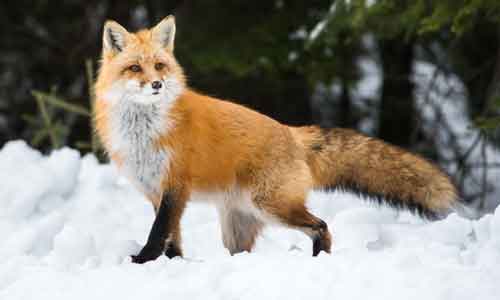
| Scientific Name: Vulpes vulpes |
| Type of Animal: Mammal |
| Family: Canidae |
| Conservation Status: Least Concern |
The red fox is widely distributed across the Northern Hemisphere including most parts of North America, North Africa, Europe, and Asia. It is the largest species of true foxes. Red foxes can be found in many diverse habitats such as forests, mountains, grasslands, and deserts.
The red fox is a cunning and adaptable predator that is found in jungles all over the world. These beautiful creatures are known for their distinctive red coat, which provides excellent camouflage in the woods. They are also incredibly fast and can run up to 45 miles per hour.
They are omnivorous and their diet includes both animals and plants. Their diet primarily consists of small mammals like voles, mice, ground squirrels, rabbits, hamsters, deer mice, and gerbils, they also consume birds, reptiles, raccoons, eggs, insects, fruits, and carrion.
So, there you have it – these awesome inspiring large animals that live in the jungle. Are you an avid wildlife enthusiast? Why not plan a trip to the woods and see them for yourself? You won’t regret it!
Small Mammals: Exploring the Small Animals in the Jungle
The jungle is teeming with all sorts of creatures, big and small. In this section, we’ll be taking a closer look at the small mammals that call the jungle home. These furry critters may be small in size, but they certainly make a big impact on the ecosystem. From their essential role in seed dispersal to their cute and cuddly appearances, these small animals in the jungle are worth getting to know.
1. Eastern Chipmunk
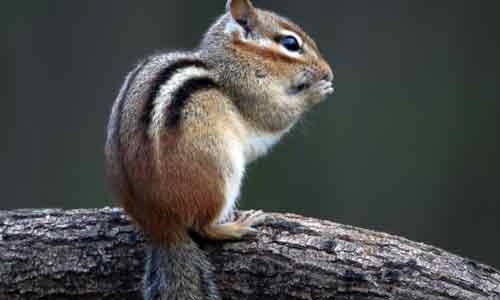
| Scientific Name: Tamias striatus |
| Type of Animal: Mammal |
| Family: Sciuridae |
| Conservation Status: Least Concern |
Eastern Chipmunk is a small rodent found in eastern North America. They are the living member of the Squirrel family, Sciuridae.
These little guys are a common sight in the jungle, darting around and gathering nuts and seeds for winter storage. With their adorable stripes and bushy tails, it’s hard not to fall in love with them.
Eastern chipmunks are active during the daytime. They are omnivores creatures that feed on different foods which include nuts, fruits, seeds, insects, and small vertebrates such as birds and lizards.
2. Red-backed Vole
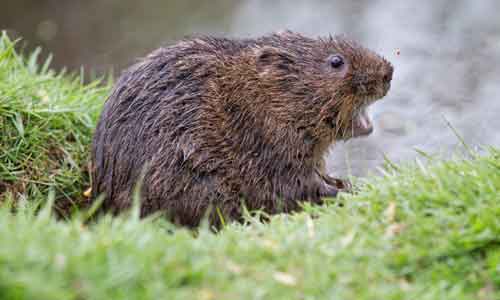
| Scientific Name: Myodes gapperi |
| Type of Animal: Mammal |
| Family: Cricetidae |
| Conservation Status: Least Concern |
The Red-backed Vole is also called the Northern Red-backed Vole. It is a small mammal found in Canada and the northern United States.
This small, mouse-like creature is an expert at hiding in the jungle floor’s underbrush. They have reddish-brown fur on their backs and a white underbelly. Although they may not be the most eye-catching animal in the jungle, their essential role in soil aeration makes them a valuable part of the ecosystem.
Red-backed voles are omnivorous and their diet consists of fruits, grasses, seeds, lichens, fungi, insects, and meat. They are found in coniferous forests, deciduous forests, and mixed forests.
3. American Red Squirrel
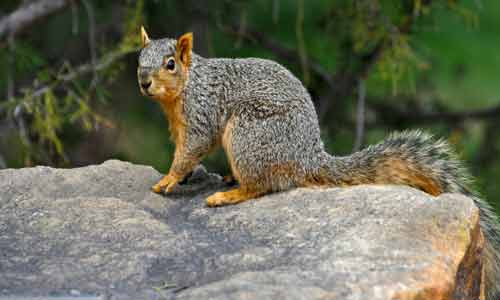
| Scientific Name: Tamiasciurus hudsonicus |
| Type of Animal: Mammal |
| Family: Sciuridae |
| Conservation Status: Least Concern |
The American red squirrel is a small, diurnal species of squirrel found throughout much of the continent of North America. The American red squirrel is also known as the pine squirrel. They are easily recognized by their reddish-brown fur, white underbelly, and bushy tail.
These small squirrels are a common sight in the jungle with their bushy tails and reddish fur. They may be small but have prominent personalities, often chattering and scolding other animals who get too close to their territory.
American red squirrels are arboreal, meaning they spend most of their time in trees, and they are most commonly found in coniferous forests. Their diet consists of a variety of foods, including fruits, seeds or cons, nuts, mushrooms, and insects.
4. Pygmy Shrew
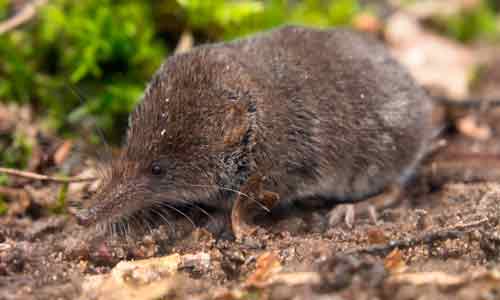
| Scientific Name: Sorex minutus |
| Type of Animal: Mammal |
| Family: Soricidae |
| Conservation Status: Least Concern |
The pygmy shrew is a small insectivorous mammal found in parts of Europe and Asia. They have small eyes, a large nose, dark brown or greyish-brown fur on their backs, and lighter hairs on their underbelly.
Don’t let their tiny size fool you – these little shrews are fierce hunters. They have a high metabolism and must constantly eat to stay alive, so they spend their days darting around the jungle floor, searching for insects and other small prey.
Pygmy shrews are active during the day and night. They are insectivores and mainly consume a wide variety of food including insects, spiders, and woodlice. Despite their small size, pygmy shrews play an important role in their ecosystem by controlling populations of insects and other small invertebrates.
5. Flying Squirrel

| Scientific Name: Pteromyini (tribe) |
| Type of Animal: Mammal |
| Family: Sciuridae |
| Conservation Status: Endangered |
Flying squirrels are a group of nocturnal rodents belonging to the Sciuridae family. Flying Squirrels are found in North America, northern Europe, and Asia.
These nocturnal creatures may be small, but they have a unique way of getting around – by gliding through the air! With flaps of skin between their front and back legs, they can glide from tree to tree in search of food.
Flying squirrels are omnivores, which means they eat both plants and animals, consuming a wide variety of foods including seeds, berries, insects, and fungi. These are social animals and are generally found in groups of two to ten individuals.
Birds and Reptiles: Feathered Flyers and Scaly Crawlers of the Jungle
The jungle is home to mammals and various fascinating birds and reptiles. Here are some feathered flyers and scaly crawlers calling the jungle their home. Let’s explore the fascinating behavior and grace and vibrant colors of flying birds with wings.
1. Wild Turkey

| Scientific Name: Meleagris gallopavo |
| Type of Animal: Bird |
| Family: Phasianidae |
| Conservation Status: Least Concern |
The wild turkey is a large majestic bird native to North America. These ground-dwelling birds can be found in different habitats such as forests, swamps, and grasslands.
These large, plump birds are known for their impressive courtship displays, with their featherless heads and necks covered with red, blue, and white skin, and distinct fanned-out tail feathers. You might even spot a group of wild turkeys wandering through the jungle if you’re lucky.
Wild turkey birds are omnivorous, and their diet includes different food such as fruits, nuts, seeds, buds, fern fronds, insects, acorns, and other small animals. These birds are social birds that stay in groups called flocks.
2. Timber Rattlesnake

| Scientific Name: Crotalus horridus |
| Type of Animal: Reptile |
| Family: Viperidae |
| Conservation Status: Endangered |
The timber rattlesnake is a species of pit viper endemic native to eastern parts of North America. These are found in forested regions of the eastern United States from southern Minnesota and southern New Hampshire, south to East Texas and North Florida.
This venomous reptile might be frightening to some, but it plays a vital role in controlling rodent populations in the jungle. You’re unlikely to come across one as they are typically reclusive but give them a wide berth if you do.
Timber rattlesnakes are ambush hunters and their diet consists of small mammals, such as mice, squirrels, rats, mice, rabbits, and occasionally birds, lizards, frogs, and other snakes.
3. Pileated Woodpeckers
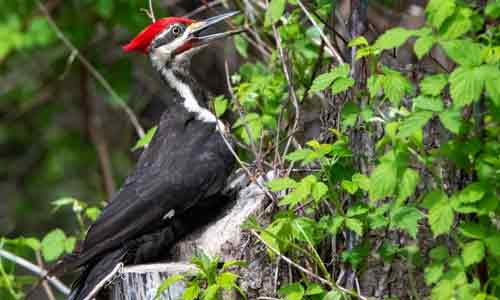
| Scientific Name: Dryocopus pileatus |
| Type of Animal: Bird |
| Family: Picidae |
| Conservation Status: Endangered |
The Pileated Woodpecker is one of the largest species of woodpecker that is native to North America. These are found in forest areas across Canada, the eastern United States, and as well as parts of the Pacific Coast.
These are hard to miss with their striking red crest and powerful beaks. They use their strong beaks to chisel through tree bark for insects, making a distinct knocking sound you will hear throughout the jungle.
Pile woodpeckers are primarily arboreal. They spend most of their time in trees where they search for food. Their diet includes a variety of insects, carpenter ants, beetle larvae as well as fruits, nuts, and seeds.
4. Eastern Box Turtle

| Scientific Name: Terrapene carolina |
| Type of Animal: Reptile |
| Family: Emydidae |
| Conservation Status: Vulnerable |
The eastern box turtle is a subspecies of the common box turtle native to the eastern part of the United States. They are commonly found in a variety of habitats including forests, grasslands, and wetlands.
These shy and slow-moving turtles often hide in the jungle underbrush. They are known for their intricate shell patterns and orange and yellow markings on their shells. Eastern Box Turtles can live for long decades in the wild.
Eastern Box Turtles are omnivorous and their diet includes a variety of foods such as grasses, fallen fruits, earthworms, snails, slugs, insects, caterpillars, beetles, berries, roots, flowers, mushrooms, and small animals.
5. Northern Saw-Whet Owl
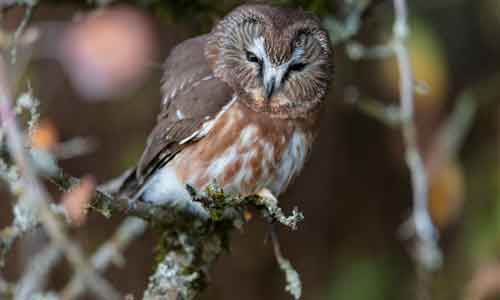
| Scientific Name: Aegolius acadicus |
| Type of Animal: Bird |
| Family: Strigidae |
| Conservation Status: Least Concern |
The northern saw-whet owl is a small species of owl belonging to the Strigidae family. It is found in North America, Alaska, Canada, most of the United States, and central mountain Mexico.
These small, nocturnal birds might be hard to spot during the day, but you can often hear their distinctive hoots echoing through the jungle at night, hunting for prey such as small birds, rodents, and insects.
The northern saw-whet owl is a migratory bird with no strict pattern. They are known for their big yellow eyes, large heads, long beaks, and fluffy feathers, making them a favorite among birdwatchers.
Whether you’re a fan of birds or reptiles, there’s no shortage of fascinating creatures to discover in the jungle.
Final Thoughts
Well, there you have it, folks! With these 18 amazing animals in the jungle that call the jungle their home, they will leave you in awe. All of these amazing animals are a true testament to the diversity and wonder of our natural world.
Whether you’re a jungle enthusiast or simply love a good adventure, exploring the habitats in the jungle of these jungle creatures is sure to be an experience you’ll never forget. So grab your binoculars and hiking boots, and get ready to witness the magic of the jungle animals in person. Who knows, you might even discover some hidden gems of your own!
If you still have any questions regarding this blog post, please let us know in the comment section below. We will definitely help you. Also, tell us what your favorite jungle animal is. We would love to hear from you.
Also Read: